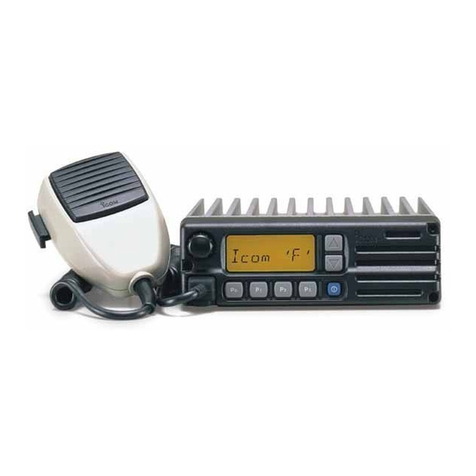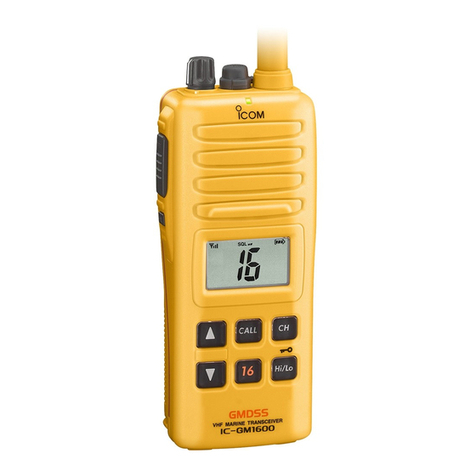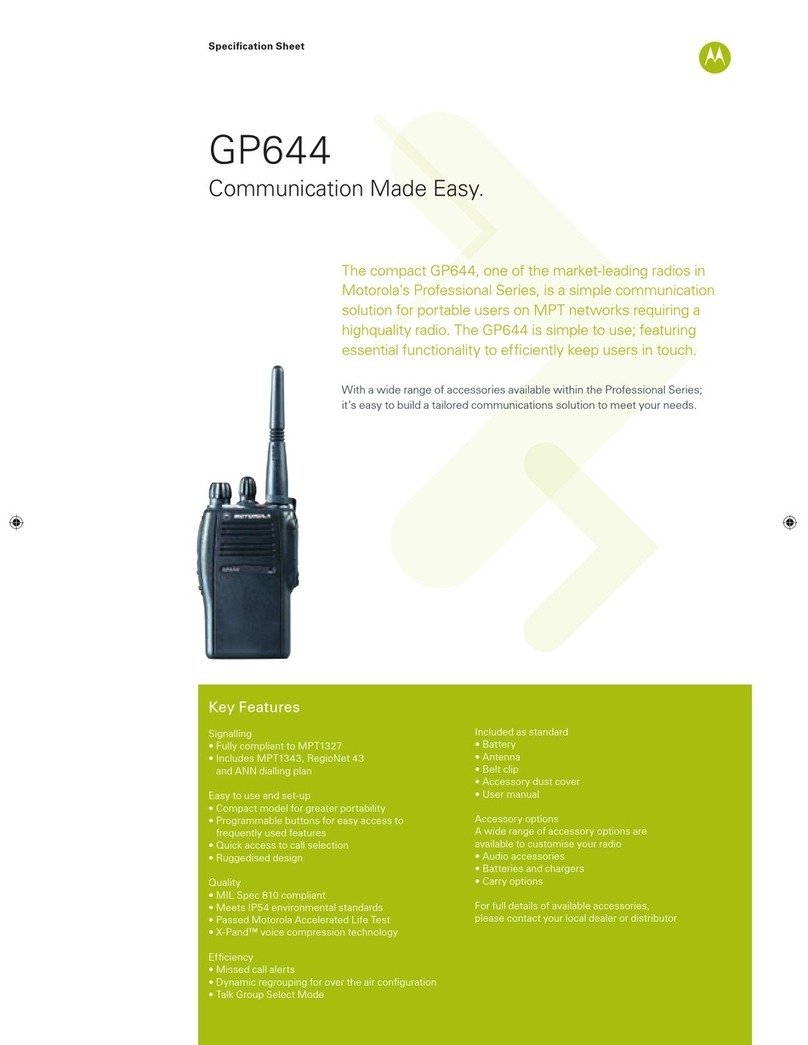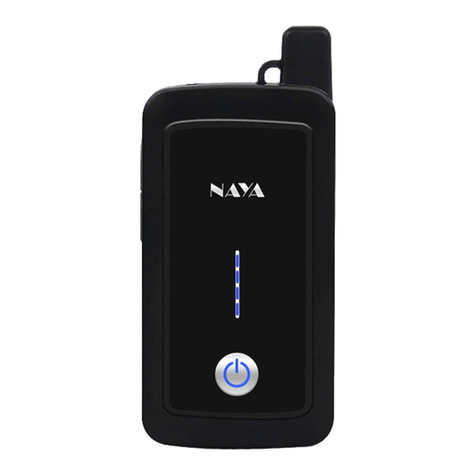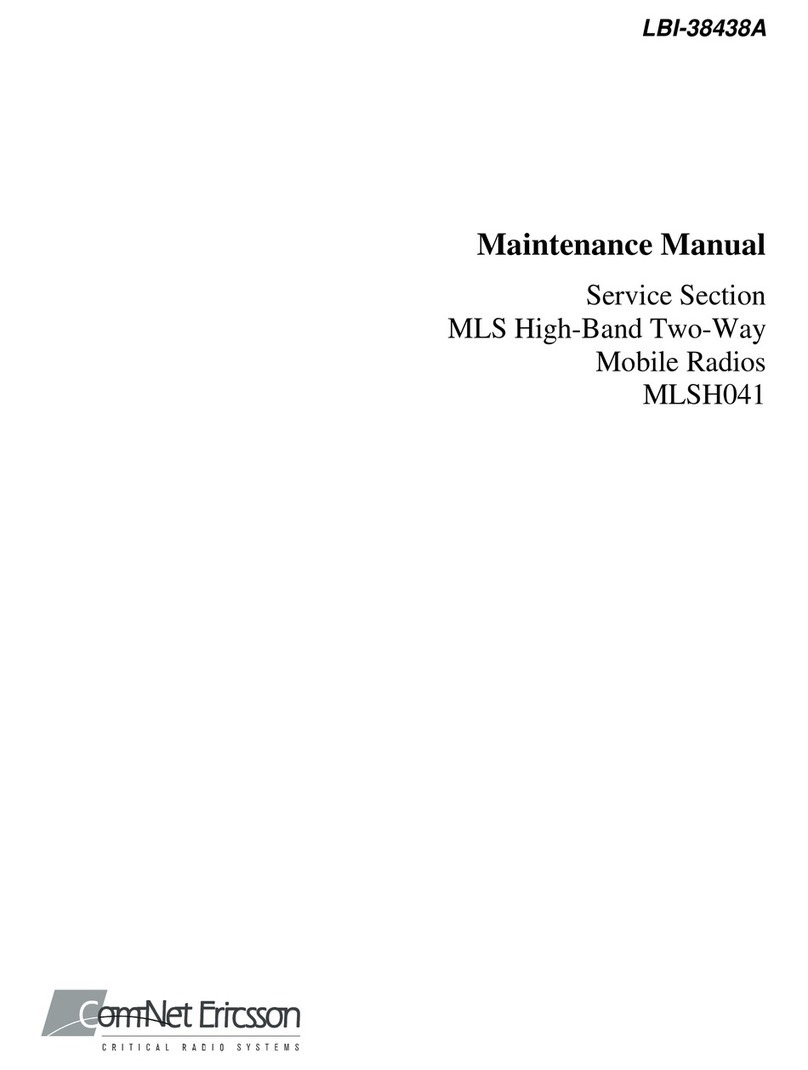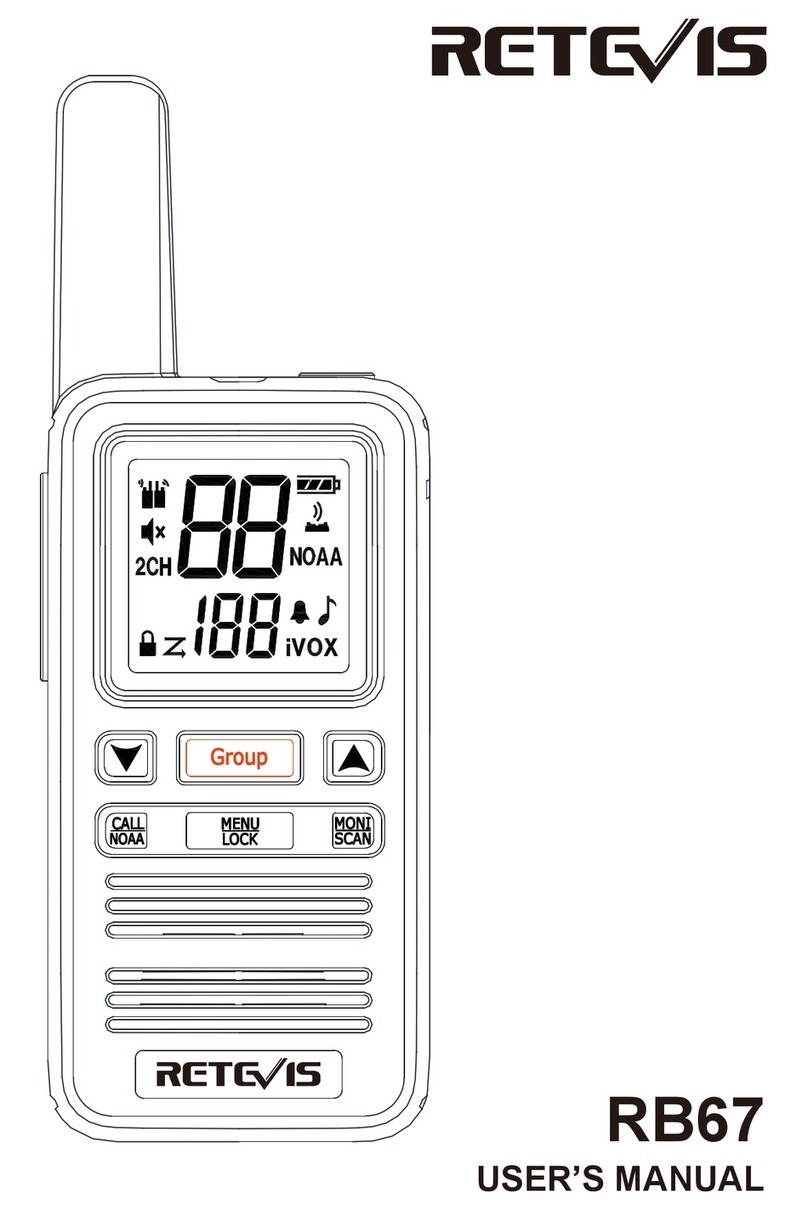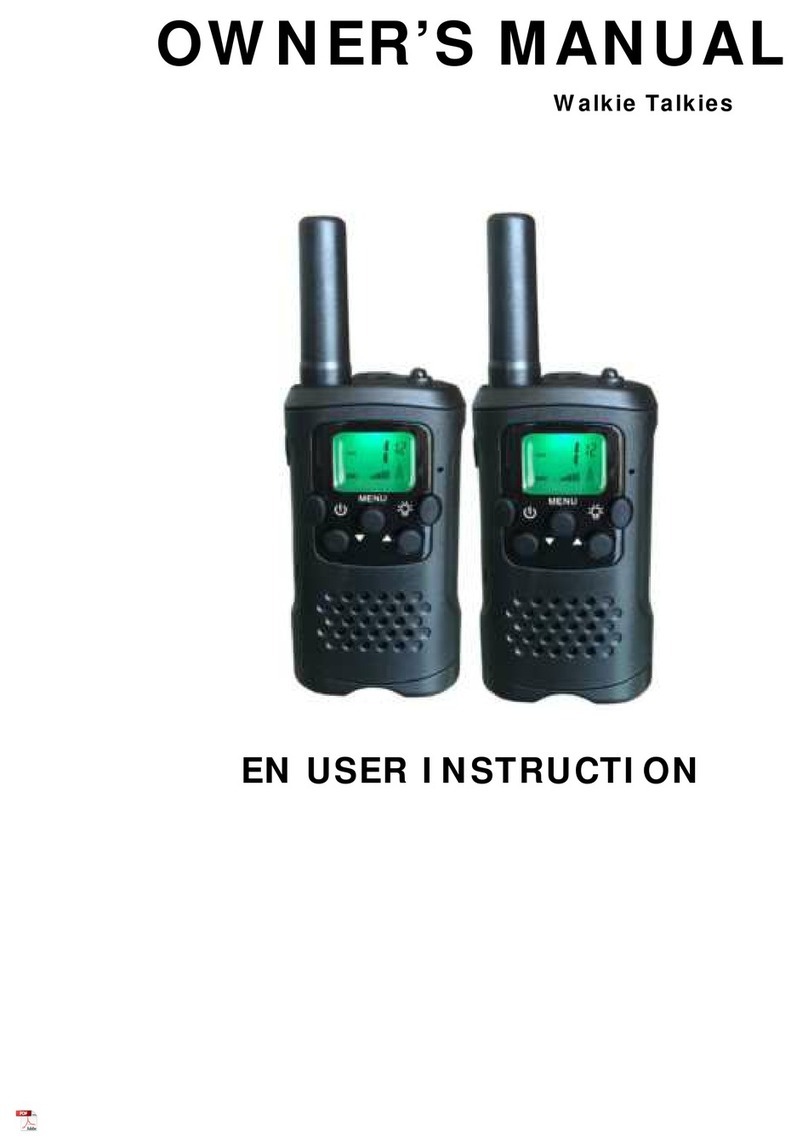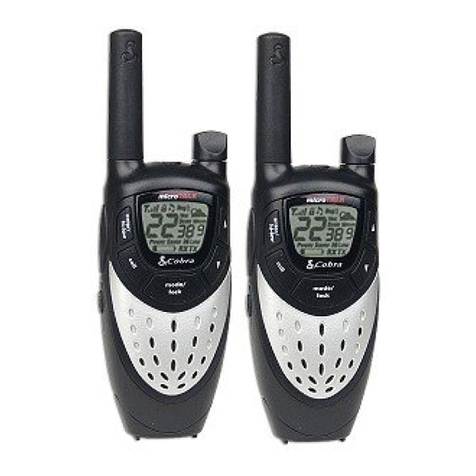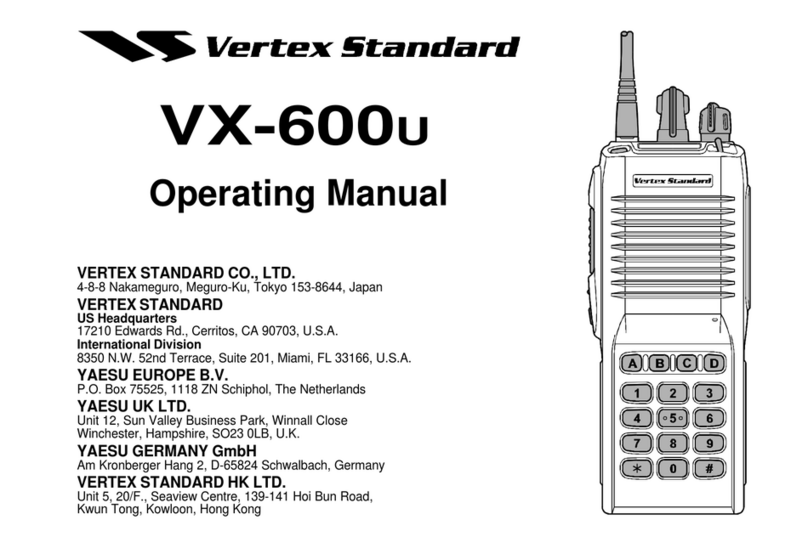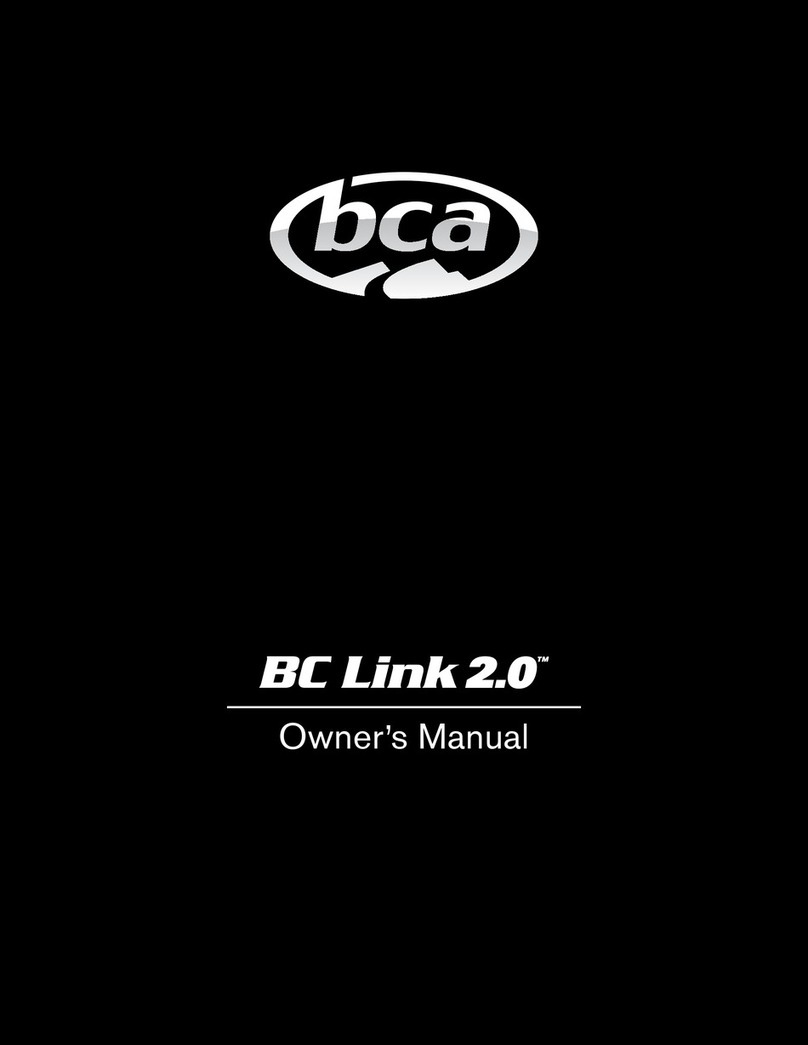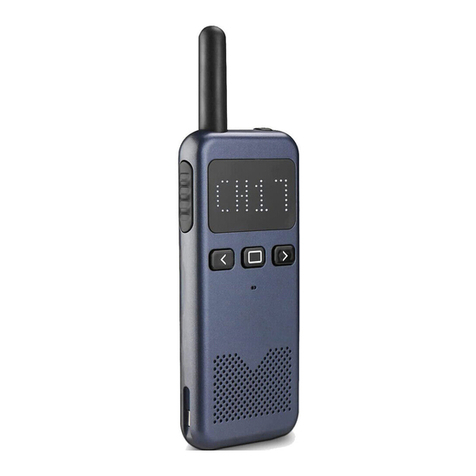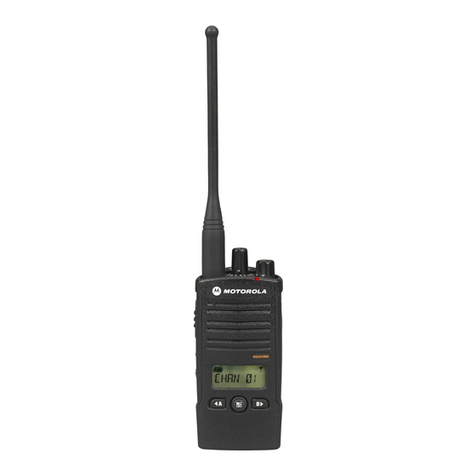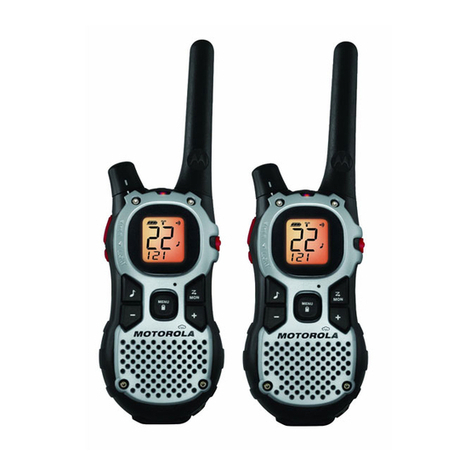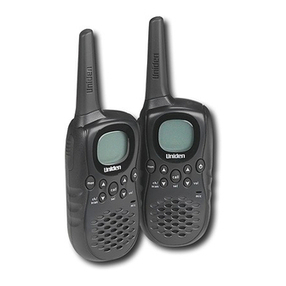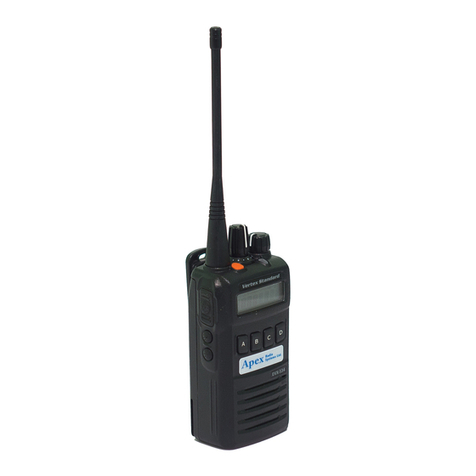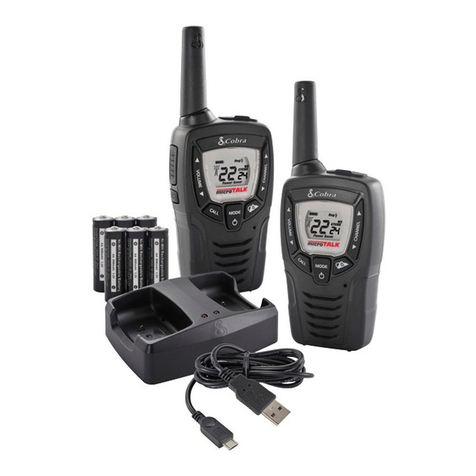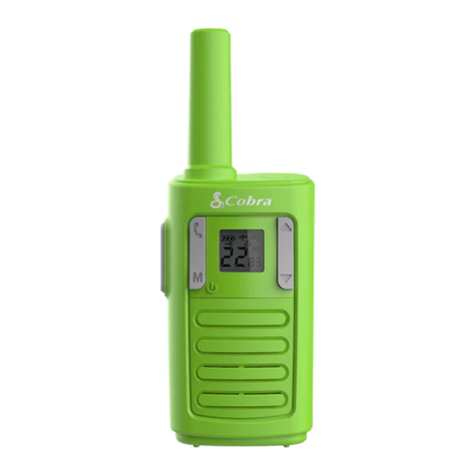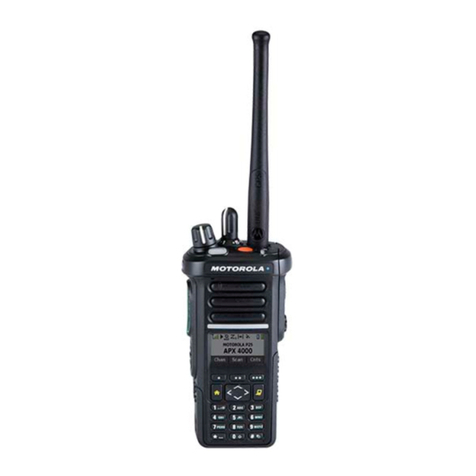Icom IC-SAT100 Installation guide

DEUTSCH
BASIS BEDIENUNGSANLEITUNG
MANUALE BASE
ITALIANO
MANUAL BÁSICO
ESPAÑOL
FRANÇAIS
NOTICE DE BASE
ENGLISH
BASIC MANUAL
|SAT100
SATELLITE PTT
SATELLIT PTT
PTT SATELITE
PTT SATELLITE
PTT SATELLITARE

1
BASIC MANUAL
Thank you for choosing this Icom product.
This product is designed and built with Icom’ s state of the art technology and craftsmanship.
With proper care, this product should provide you with years of trouble-free operation.
■Important
READ ALL INSTRUCTIONS carefully and completely before using the transceiver.
SAVE THIS INSTRUCTION MANUAL — This instruction manual contains important
operating instructions for the IC-SAT100.
For Advanced features and instructions, see the OPERATING MANUAL on the Icom
website for details.
http://www.icom.co.jp/world/support/
■Explicit denitions
WORD DEFINITION
RDANGER! Personal death, serious injury or an explosion may occur.
RWARNING! Personal injury, re hazard or electric shock may occur.
CAUTION Equipment damage may occur.
NOTE If disregarded, inconvenience only. No risk of personal injury, re or
electric shock.
■Features
zReal-Time Communication with the Iridium®LEO (Low Earth Orbit) satellite network,
covering all over the globe including the Poles
zOne-to-many communication (Maximum 15 Groups)
z1500 mW powerful audio
zMultiple language (Chinese, English, French, Japanese, and Spanish)
■Supplied accessories
NOTE: Some accessories are not supplied, or the shape is different, depending on the
transceiver version.
Battery pack Belt clip
Battery charger
Antenna
Power adapter
(with adapter plugs)
ENGLISH

2
BASIC MANUAL
1
2
3
1
2
3
ENGLISH
■Precautions
R DANGER! NEVER use or charge Icom
battery packs with non-Icom transceivers
or non-Icom chargers. Only Icom battery
packs are tested and approved for use with
Icom transceivers or charged with Icom
chargers. Using third-party or counterfeit
battery packs or chargers may cause
smoke, re, or cause the battery to burst.
R WARNING! NEVER hold the
transceiver so that the antenna is very
close to, or touching exposed parts of the
body, especially the face or eyes, while
transmitting.
R WARNING! NEVER operate the
transceiver with a headset or other
audio accessories at high volume levels.
The continuous high volume operation
may cause a ringing in your ears. If you
experience the ringing, reduce the volume
level or discontinue use.
CAUTION: DO NOT short the terminals of
the battery pack. Shorting may occur if the
terminals touch metal objects such as a
key, so be careful when placing the battery
packs (or the transceiver) in bags, and so
on. Carry them so that shorting cannot
occur with metal objects. Shorting may
damage not only the battery pack, but also
the transceiver.
CAUTION: DO NOT use harsh solvents
such as Benzine or alcohol when cleaning.
This could damage the equipment
surfaces. If the surface becomes dusty or
dirty, wipe it clean with a soft, dry cloth.
CAUTION: DO NOT place or leave
the transceiver in excessively dusty
environments. This could damage the
transceiver.
DO NOT place or leave the transceiver in
direct sunlight or in areas outside of the
specied temperature range:
–30°C (–22˚F) ~ +60°C (+140˚F)
BE CAREFUL! The transceiver meets
IP67* requirements for dust tight and
waterproof protection. However, once
the transceiver has been dropped, dust
and waterproof protections cannot be
guaranteed due to the fact that the
transceiver may be cracked, or the
waterproof seal damaged, and so on.
* Only when the jack cover or the optional
speaker microphone is attached.
NEVER place the transceiver in an
insecure place to avoid inadvertent use by
unauthorized persons.
In some countries, using a satellite
communication device may be prohibited,
or a license is required. Make sure you
comply with all applicable laws and
regulations in your area.
Icom, Icom Inc. and Icom logo are registered
trademarks of Icom Incorporated
(Japan) in Japan, the United States, the United
Kingdom, Germany, France, Spain, Russia,
Australia, New Zealand, and/or other countries.
The Bluetooth®word mark and logos are registered
trademarks owned by Bluetooth SIG, Inc. and any
use of such marks by Icom Inc. is under license.
Other trademarks and trade names are those of their
respective owners.
3M, PELTOR, and WS are trademarks of 3M Company.
All other products or brands are registered
trademarks or trademarks of their respective holders.
Iridium, and the Iridium logo are registered
trademarks of Iridium Satellite LLC and its afliates.

3
BASIC MANUAL
■Important notes
DAbout the GPS receiver
• Do not cover the antenna with anything that
will block the satellite signals.
• GPS signals cannot pass through metal
objects. When using the transceiver inside
a vehicle, you may not receive GPS signals.
We recommend you use it near a window.
• The GPS receiver may not work if used in
the following locations:
1. Tunnels or high-rise buildings
2. Underground parking lots
3. Under a bridge or viaduct
4. In remote forested areas
5. Under bad weather conditions
(rainy or cloudy day)
• The Global Positioning System (GPS) is built
and operated by the U.S. Department of
defense. The Department is responsible for
accuracy and maintenance of the system.
Any changes by the Department may affect
the accuracy and function of the GPS
system.
■Recommendation
CLEAN THE TRANSCEIVER
THOROUGHLY IN A BOWL OF FRESH
WATER after exposure to saltwater,
and dry it before operating. Otherwise,
the transceiver’s keys, switches, and
controllers may become unusable, due
to salt crystallization, and/or the charging
terminals of the battery pack may corrode.
NOTE: If the transceiver’s waterproof
protection appears defective, carefully clean
it with a soft, damp (fresh water) cloth, then
dry it before operating. The transceiver may
lose its waterproof protection if the case, jack
cap, or connector cover is cracked or broken,
or the transceiver has been dropped. Contact
your Icom distributor or your dealer for advice.
Icom is not responsible for the destruction, damage to, or performance of any Icom or
non-Icom equipment, if the malfunction is because of:
• Force majeure, including, but not limited to, res, earthquakes, storms, oods, lightning,
other natural disasters, disturbances, riots, war, or radioactive contamination.
• The use of Icom transceivers with any equipment that is not manufactured or approved by
Icom.

4
BASIC MANUAL
1
2
3
1
2
3
ENGLISH
■Table of contents
■Important...............................................................................................................1
■Explicit denitions..................................................................................................1
■Features................................................................................................................1
■Supplied accessories ............................................................................................1
■Precautions ...........................................................................................................2
■Important notes .....................................................................................................3
■Recommendation..................................................................................................3
1 PANEL DESCRIPTION.............................................................................................5
■Front, top and side panels.....................................................................................5
■Function display ....................................................................................................6
2 BATTERY CHARGING .............................................................................................7
■Battery caution ......................................................................................................7
■Charging caution...................................................................................................8
■Battery charger......................................................................................................9
3 MENU SCREEN........................................................................................................10
■Construction..........................................................................................................10
4 BASIC OPERATION.................................................................................................11
■Receiving and transmitting....................................................................................11
5 OPTIONS ..................................................................................................................12
6 INFORMATION .........................................................................................................13
■About CE and DOC...............................................................................................13
■Disposal ................................................................................................................13
■Certication ...........................................................................................................13
■FCC information....................................................................................................13
■Safety training information ....................................................................................14

5
BASIC MANUAL
1PANEL DESCRIPTION
1 EMERGENCY KEY [EMER]
Hold down to transmit an Emergency
call.
2 PTT SWITCH [PTT]
Hold down to transmit, release to receive.
3 P1/P2 KEYS [P1]/[P2]
Push to use the function assigned in the
“Key Setup” menu*.
*[OK] > Functions > Key Setup
4 MENU/OK KEY [OK]
zPush to enter the Menu screen.
zPush to select an item in the Menu
screen.
5 BACK/HOME KEY [BACK]
zPush to return to the previous Menu
screen.
zHold down to exit the Menu screen.
6 DIRECTIONAL KEY [UP]/[DOWN]/
[LEFT]/[RIGHT]
Push to select a menu item, setting, and
so on.
7 MULTI-CONNECTOR
Connects to an optional headset.
8 STATUS INDICATOR
zLights green while receiving.
zBlinks green while the “OPEN” status.
zLights red while transmitting.
zBlinks orange while registering, or no
satellites found.
9 VOLUME/POWER SWITCH [VOL]
zRotate to turn the transceiver ON or
OFF.
zRotate to adjust the audio output level.
TALKGROUP SELECTOR
Rotate to select a talkgroup.
■Front, top and side panels
1
9
7
5
4
2
Microphone
Speaker
Micro USB Connector
Antenna Connector
3
6
8

6
PANEL DESCRIPTION 1
BASIC MANUAL
1
2
3
1
2
3
ENGLISH
■Function display
DIcon Area
Indicators
1SIGNAL STRENGTH
Displays the relative receive signal strength
level.
2CLOCK
Displays the current time.
3BATTERY
Displayed or blinks to indicate the battery
status.
Full Mid Charging
required
Battery
exhausted
Icons
The following icons are displayed in the
Icon Area.
LOCK
Displayed when the Lock function is ON.
SURVEILLANCE
Displayed when the Surveillance function
is ON.
VIBRATION
Displayed when the Vibration function is ON.
Bluetooth®
• “ ” is displayed when Bluetooth is activated.
• “ ” is displayed when a Bluetooth device is
connected.
MESSAGE
• Blinks after messages (Message or Status
Message) have been received.
• Displayed if unread messages are still in the
Message memory.
RECORD
Displayed when the Record function is ON.
USB
Displayed when a USB device is connected.
DText Area
Displays the status, preset transceiver
name, and selected Talkgroup Name.
Status Description
IDLE The selected Talkgroup is
not active.
OPEN The selected talkgroup
is active but no one is
talking.
REQUESTING Requesting the
transmission.
TALKING Transmitting
LISTENING Receiving
SCANNING Scanning a call
DKey Display Area
Displays the names of the function
assigned to [P1] and [P2].
LThe display is shown in English as an example. Select other languages on the Menu
screen, if necessary. ([OK] > Display > Language)
1 3
TG List Scan
00:00 Icon area
Text area
Key display area
2

7
BASIC MANUAL
2BATTERY CHARGING
■Battery caution
Misuse of Li-ion batteries may result in the
following hazards: smoke, re, or the battery
may rupture. Misuse can also cause damage
to the battery or degradation of battery
performance.
RDANGER! NEVER solder the battery
terminals, or NEVER modify the battery pack.
This may cause heat generation, and the
battery may burst, emit smoke or catch re.
RDANGER! NEVER place or leave battery
packs in areas with temperatures above 50°C
(122°F). High temperature buildup in the
battery cells, such as could occur near res
or stoves, inside a sun-heated vehicle, or in
direct sunlight for long periods of time may
cause the battery cells to rupture or catch re.
Excessive temperatures may also degrade
the battery pack’s performance or shorten the
battery cell’s life.
RDANGER! NEVER strike or otherwise
impact the battery pack. Do not use the
battery pack if it has been severely impacted
or dropped, or if the pack has been subjected
to heavy pressure. Battery pack damage may
not be visible on the outside of the case. Even
if the surface of the battery does not show
cracks or any other damage, the cells inside
the battery may rupture or catch re.
RDANGER! NEVER place battery packs
near a re. Fire or heat may cause them to
rupture or explode. Dispose of used battery
packs in accordance with local regulations.
RDANGER! NEVER let uid from inside
the battery get in your eyes. This can cause
blindness. Rinse your eyes with clean water,
without rubbing them, and immediately go to
a doctor.
RWARNING! NEVER put the battery pack in
a microwave oven, high-pressure container,
or in an induction heating cooker. This could
cause a re, overheating, or cause the battery
cells to rupture.
RWARNING! NEVER Iet uid from inside the
battery cells come in contact with your body. If
it does, immediately wash with clean water.
RWARNING! NEVER use deteriorated
battery packs. They could cause a re.
CAUTION: DO NOT continue to use the
battery pack if it emits an abnormal odor,
heats up, or is discolored or deformed. If any
of these conditions occur, contact your Icom
dealer or distributor.
CAUTION: DO NOT expose the battery pack
to rain, snow, saltwater, or any other liquids.
Do not charge or use a wet pack. If the pack
gets wet, be sure to wipe it with a clean dry
cloth before using.
CAUTION: DO NOT use the battery pack
out of the specied temperature range for
the transceiver (–30°C ~ +60°C (–22°F ~
+140°F)) and the battery itself (–20°C ~
+60°C (–4°F ~ +140°F)). Using the battery out
of its specied temperature range will reduce
its performance and battery cell’s life. Please
note that the specied temperature range of
the battery may exceed that of the transceiver.
In such cases, the transceiver may not work
properly because it is out of its operating
temperature range.
CAUTION: DO NOT leave the pack fully
charged, completely discharged, or in an
excessive temperature environment (above
50°C, 122°F) for an extended period of time. If
the battery pack must be left unused for a long
time, it must be detached from the transceiver
after discharging. You may use the battery
pack until the remaining capacity is about half,
then keep it safely in a cool and dry place at
the following temperature range:
–20°C ~ +50°C (–4°F ~ +122°F)
(within a month)
–20°C ~ +40°C (–4°F ~ +104°F)
(within three months)
–20°C ~ +20°C (–4°F ~ +68°F)
(within a year)
BE SURE to replace the battery pack with
a new one approximately ve years after
manufacturing, even if it still holds a charge.
The material inside the battery cells will
become weak after a period of time, even
with little use. The estimated number of times
you can charge the pack is between 300 and
500. Even when the pack appears to be fully
charged, the operating time of the transceiver
may become short when:
• Approximately 5 years have passed since
the pack was manufactured.
• The pack has been repeatedly charged.

8
BATTERY CHARGING 2
BASIC MANUAL
1
2
3
1
2
3
ENGLISH
■Charging caution
RDANGER! NEVER charge the battery
pack in areas with extremely high
temperatures, such as near res or stoves,
inside a sun-heated vehicle, or in direct
sunlight. In such environments, the safety/
protection circuit in the battery will activate,
causing the battery to stop charging.
RWARNING! NEVER charge the
transceiver during a lightning storm. It may
result in an electric shock, cause a re or
damage the transceiver. Always disconnect
the power adapter before a storm.
RWARNING! NEVER charge or leave the
battery in the battery charger beyond the
specied time for charging. If the battery
is not completely charged by the specied
time, stop charging and remove the battery
from the battery charger. Continuing to
charge the battery beyond the specied
time limit may cause a re, overheating, or
the battery may rupture.
RWARNING! Occasionally observe the
battery pack condition while charging. If
any abnormal condition occurs, discontinue
using the battery pack.
CAUTION: DO NOT insert the transceiver
(battery attached to the transceiver) into
the charger if it is wet or soiled. This could
corrode the battery charger terminals or
damage the charger. The charger is not
waterproof.
CAUTION: DO NOT charge the battery
pack outside of the specied temperature
range: 10˚C ~ 45˚C (50˚F ~ 113˚F).
Otherwise, the charging time will be
longer, but the battery will not reach a full
charge. While charging, at a point after
the temperature goes out of the specied
range, the charging will automatically stop.

9
2BATTERY CHARGING
BASIC MANUAL
■Battery charger
NOTE: Before attaching or detaching a battery
pack, BE SURE to turn OFF the transceiver
by rotating [VOL] fully counter clockwise
until it makes a “click” sound. Otherwise, a
transceiver malfunction could occur.
DSupplied battery charger
Charging time:
Approximately 3.1 hours for the BP-300
* May not be supplied, or the shape may be
different, depending on the transceiver version.
NOTE: If the charging indicator alternately
blinks green and orange, remove the battery
pack or the transceiver from the charger,
then reinsert it. If the charging indicator
alternately still blinks green and orange, ask
your dealer for details.
Battery
charger
Charging indicator
Lights orange: Charging
Lights green: Charged
Blinks red: When a charging error has
occurred.
Battery
pack
DExtend Battery Life function
The charger has the Extend Battery Life
function switch on the bottom panel.
• OFF: The battery is fully charged. The
operating time of the transceiver is
maximum.
• ON: The battery is not fully charged to not
shorten the battery life cycle.
LThe battery life cycle is extended.
But the operating time of the
transceiver becomes shorter.
DMicro USB Connector
You can also use the Micro USB Connector to
charge instead of the supplied battery charger.
L“ ” is displayed while charging.
LCharging time may longer than using a
battery charger.
Turn OFF
Power
adapter*

10
BASIC MANUAL
1
2
3
1
2
3
ENGLISH
3
MENU SCREEN
You can use the Menu screen to set
infrequently changed values or function
settings.
■Construction
The Menu screen is constructed in a tree
structure.
You can go to the next tree level with
[RIGHT] or [OK], go back a level with
[LEFT] or [BACK].
To select an item, push [UP] or [DOWN].
See the OPERATING MANUAL for each
menu item’s details. You can download
the OPERATING MANUAL from the Icom
website.
LThe menu items contained in the
transceiver may be different, depending
on the transceiver’s version or presettings.
Ask your dealer for details.
http://www.icom.co.jp/world/support/
Talkgroup
Refresh Talkgroup
Talkgroup List
PTT Option
Talk Timer
Mic Gain
Call Recorder
Received Message
Message List
Location Sharing
Position Format
Distance Format
Bluetooth
Bluetooth ON/OFF
BT Device List
Bluetooth Reset
BT Auto Connect
BT Audio Setting
BT Device Info
Key Beep (VS-3)
PWR Save (VS-3)
PTT Beep (VS-3)
One touch PTT
Waiting Pairing
Functions
Auto Keypad Lock
Key Setup
P1 Key
P2 Key
PC Command
Clock
Clock Display
Time Format
Clock Time Zone
DST
Display
Backlight
Contrast
Language
Beep/Vibration
System Beep Lv
Emer Beep Lv
Key Beep Lv
Ringer Lv
Opening Beep Lv
System Vibration
Emer Vibration
Key Vibration
Receive Vibration
Opening Vibration
Information
Battery Information
RSSI
My Position
Firmware Info
Satellite Info
Certication

11
BASIC MANUAL
4BASIC OPERATION
■Receiving and transmitting
DTurning ON the transceiver
zRotate [VOL] to turn ON the transceiver.
• The transceiver searches a satellite.
• When the transceiver connected and
registered to the satellite, the status
“IDLE,” transceiver name, and Talkgroup
name is displayed.
LPush [TG List] to display the Talkgroup
list.
LRotate Talkgroup selector to select a
talkgroup.
DReceiving
When receiving, “LISTENING,” and the
source transceiver’s name is displayed,
and audio should be heard.
LRotate [VOL] to adjust the audio output level.
TG List Ignore
LISTENING
TRANSCEIVER02
TALKGROUP01
DTransmitting
CAUTION: DO NOT transmit without an
antenna.
1. Hold down [PTT].
L“REQUESTING” is displayed
while the transceiver requests the
transmission.
2. When “TALKING” is displayed, speak
at your normal voice level.
LYou can continuously transmit up
to the period of time allowed by the
system.
TG List Scan
TALKING
TRANSCEIVER01
TALKGROUP01
DScan and Ignore
[Scan]
Push to scan a call.
[Ignore]
Push to ignore the received call.
LThe Ignore function will be canceled if
there are no more calls for 90 seconds or
longer.
NOTE:
• The transceiver receives and
transmits using several satellites
orbiting the same orbit. Receiving
and transmitting may fail
depending on the satellite position
or any obstacles between the
transceiver and satellites.
• Your body can also be an
obstacle. Do not hook the
transceiver on your waist.

12
BASIC MANUAL
1
2
3
1
2
3
ENGLISH
5
OPTIONS
DBATTERY PACK
•BP-300 BATTERY PACK
Voltage: 7.2 V
Capacity: 2200 mAh (minimum), 2350 mAh (typical)
Approximate battery life*: 14.5 hours
* Operating periods are calculated under the following conditions.
TX : RX : standby = 5 : 5 : 90
DCHARGERS
•BC-241 DESKTOP CHARGER + BC-242 AC ADAPTER
To rapidly charge a single battery pack.
•BC-214N MULTI CHARGER + AD-140 CHARGER ADAPTER +
BC-157S AC ADAPTER
To rapidly charge up to 6 battery packs.
DOTHERS
•OPC-656 DC POWER CABLE
Use with a 13.8 V power source instead of the power adapter. (Use with the BC-214N)
•FA-S102U ANTENNA
•MBB-5 BELT CLIP
•HM-222 SPEAKER MICROPHONE
With an Emergency key.
The HM-222 meets IP68 requirements for waterproof protection.
•VS-3 Bluetooth®HEADSET
The Bluetooth® headset with a [PTT] switch.
About the third party Bluetooth® headsets:
Icom has checked the PTT operation with some 3M Peltor headsets such as the WS
Headset XP, WS ProTac XP and WS Alert XP. (Compatibility not guaranteed.)
•VS-5MC PTT SWITCH CABLE + HS-94, HS-95, HS-97 HEADSET
VS-5MC: Used to connect a headset to a transceiver.
HS-94: Ear-hook type
HS-95: Neck-arm type
HS-97: Throat microphone
• HM-163MC TIEPIN TYPE MICROPHONE
+ EH-15B EARPHONE, SP-28 EAR HOOK TYPE EARPHONE,
SP-26 TUBE EARPHONE
•SP-32 TUBE TYPE EARPHONE ADAPTER
For use with EH-15B.
• SP-27 TUBE EARPHONE, SP-29 EAR HOOK TYPE EARPHONE,
SP-40 EARPHONE + AD-135 EARPHONE ADAPTER
AD-135: Used to connect an earphone to the transceiver’s multi-connector.
• AD-118 ACC ADAPTER
Used to connect a headset with Hirose-6-pin connector to the transceiver’s multi-
connector.
Some options may not be available in some countries.
Ask your dealer for details.

13
BASIC MANUAL
6INFORMATION
■About CE and DOC
Hereby, Icom Inc. declares
that the versions of IC-
SAT100 which have
the “CE” symbol on
the product, comply with the essential
requirements of the Radio Equipment
Directive, 2014/53/EU, and the restriction
of the use of certain hazardous substances
in electrical and electronic equipment
Directive, 2011/65/EU. The full text of the
EU declaration of conformity is available at
the following internet address:
http://www.icom.co.jp/world/support/
■Disposal
The crossed-out wheeled-
bin symbol on your product,
literature, or packaging reminds
you that in the European Union,
all electrical and electronic
products, batteries, and accumulators
(rechargeable batteries) must be taken
to designated collection locations at the
end of their working life. Do not dispose
of these products as unsorted municipal
waste. Dispose of them according to the
laws in your area.
■Certication
Refer to the “Certication” screen for
certications acquired with the transceiver.
([OK] > Information > Certication)
Certication
■FCC information
This device complies with part 15 of the
FCC Rules. Operation is subject to the
following two conditions:
1. This device may not cause harmful
interference, and
2. This device must accept any
interference received,
Including interference that may cause
undesired operation.
This equipment has been tested and found
to comply with the limits for a Class B
digital device, pursuant to part 15 of the
FCC Rules.
These limits are designed to provide
reasonable protection against harmful
interference in a residential installation.
This equipment generates, uses and
can radiate radio frequency energy and,
if not installed and used in accordance
with the instructions, may cause harmful
interference to radio communications.
However, there is no guarantee that
interference will not occur in a particular
installation. If this equipment does cause
harmful interference to radio or television
reception, which can be determined by
turning the equipment off and on, the
user is encouraged to try to correct the
interference by one or more of the following
measures:
• Reorient or relocate the receiving antenna.
• Increase the separation between the
equipment and receiver.
• Connect the equipment into an outlet on
a circuit different from that to which the
receiver is connected.
• Consult the dealer or an experienced radio/
TV technician for help.
CAUTION: Changes or modications to
this transceiver, not expressly approved
by Icom Inc., could void your authority
to operate this transceiver under FCC
regulations.

14
INFORMATION 6
BASIC MANUAL
1
2
3
1
2
3
ENGLISH
Your Icom radio generates
RF electromagnetic energy
while transmitting. This radio is
designed for and classied as
for “Occupational Use Only.”
This means it must be used only during
the course of employment by individuals
aware of the hazards, and the ways to
minimize such hazards. This radio is
NOT intended for use by the “General
Population” in an uncontrolled environment.
This radio has been tested and complies
with the FCC and IC RF exposure limits
for “Occupational Use Only”. In addition,
your Icom radio complies with the following
Standards and Guidelines with regard to
RF energy and electromagnetic energy
levels and evaluation of such levels for
exposure to humans:
• FCC KDB Publication 447498 D03,
Evaluating Compliance with FCC Guidelines
for Human Exposure to Radio Frequency
Electromagnetic Fields.
• American National Standards Institute
(C95.1-2010), IEEE Standard for Safety
Levels with Respect to Human Exposure to
Radio Frequency Electromagnetic Fields, 3
kHz to 300 GHz.
• American National Standards Institute
(C95.3-2002), IEEE Recommended
Practice for the Measurement of Potentially
Hazardous Electromagnetic Fields– RF and
Microwave.
• The accessories listed on page 1 are
authorized for use with this product. Use of
accessories other than those specied may
result in RF exposure levels exceeding the
FCC requirements for wireless RF exposure.
• Health Canada Safety Code 6 - Limits of
Human Exposure to Electromagnetic Energy
in the Frequency Range from 3 kHz to
300 GHz.
To ensure that your expose
to RF electromagnetic energy
is within the FCC allowable
limits for occupational use,
always adhere to the following
guidelines:
• DO NOT operate the radio without a proper
antenna attached, as this may damage the
radio and may also cause you to exceed
FCC RF exposure limits. A proper antenna
is the antenna supplied with this radio by
the manufacturer or an antenna specically
authorized by the manufacturer for use with
this radio.
• DO NOT transmit for more than 50% of
the total radio use time (“50% duty cycle”).
Transmitting more than 50% of the time
can cause FCC RF exposure compliance
requirements to be exceeded. The radio is
transmitting when “TALKING” is displayed on
the function display. You can cause the radio
to transmit by pushing the [PTT] switch.
•ALWAYS keep the antenna at least 2.5
cm (1 inch) away from the body when
transmitting and only use the Icom belt-
clips which are listed on page 12 when
attaching the radio to your belt, or other
place, to ensure FCC and IC RF exposure
compliance requirements are not exceeded.
The information listed above provides the
user with the information needed to make
him or her aware of RF exposure, and what
to do to assure that this radio operates
within the FCC RF exposure limits of this
radio.
Electromagnetic Interference/
Compatibility
During transmissions, your Icom radio
generates RF energy that can possibly
cause interference with other devices
or systems. To avoid such interference,
turn off the radio in areas where signs
are posted to do so. DO NOT operate the
transmitter in areas that are sensitive to
electromagnetic radiation such as hospitals
and blasting sites.
Occupational/Controlled Use
The radio transmitter is used in situations
in which persons are exposed as
consequence of their employment provided
those persons are fully aware of the
potential for exposure and can exercise
control over their exposure.
WARNING
CAUTION
■Safety training information

15
GRUNDHANDBUCH
Vielen Dank dafür, dass Sie dieses Icom-Produkt erworben haben. Dieses Produkt wurde auf der
Basis der hochmodernen Technologie und Kompetenz von Icom entwickelt und gebaut. Mit der
richtigen Pege sollte dieses Produkt Ihnen viele Jahre störungsfreien Betrieb bieten.
■Wichtig
LESEN SIE ALLE ANWEISUNGEN sorgfältig und vollständig durch, bevor Sie den
Transceiver verwenden.
BEWAHREN SIE DIESE BEDIENUNGSANLEITUNG AUF — diese Bedienungsanleitung
enthält wichtige Hinweise für den Betrieb des IC-SAT100.
Hinweise zu Einzelheiten der erweiterten Funktionen und Anweisungen nden Sie im
BEDIENUNGSHANDBUCH auf der Icom-Website.
http://www.icom.co.jp/world/support/
Die detailierte Bedienungsanleitung steht Ihnen auf unserer Webseite unter
www.icomeurope.com zum Download bereit.
■Denitionen der Kennzeichnungen
BEGRIFF DEFINITION
RGEFAHR!
Lebensgefahr, Gefahr von schweren Verletzungen oder Explosionsgefahr.
RRWARNUNG! Es besteht die Gefahr von Verletzungen, Bränden oder elektrischen
Schlägen.
ACHTUNG Das Gerät kann beschädigt werden.
HINWEIS
Bei Nichtbeachtung werden die Geräteeigenschaften nicht vollständig. Es
besteht keine Gefahr von Personenschäden,Brand oder Stromschlägen.
■Leistungsmerkmale
zEchtzeitkommunikation mit dem Satellitennetzwerk Iridium®, das den gesamten Globus
einschließlich der Pole abdeckt
zOne-to-Many-Kommunikation (maximal 15 Gruppen)
zStarke Audioleistung von 1.500 mW
zMehrsprachig (Chinesisch, Englisch, Französisch, Japanisch und Spanisch)
■Mitgeliefertes Zubehör
HINWEIS: Je nach der Transceiver-Version sind einige Zubehörteile u. U. nicht im
Lieferumfang enthalten oder anders geformt.
Akkupack Gürtelclip
Akkuladegerät
AntenneNetzadapter
(mit Adaptersteckern)
DEUTSCH

16
GRUNDHANDBUCH
1
4
2
3
DEUTSCH
■Sicherheitshinweise
R GEFAHR! Benutzen Sie Icom-
Akkupacks NIEMALS mit Transceivern
oder Ladegeräten, die nicht von Icom
stammen. Nur Icom-Akkupacks sind für
die Verwendung mit Icom-Transceivern
oder zum Auaden mit Icon-Ladegeräten
getestet und zugelassen. Die Benutzung
von Akkupacks oder Ladegeräten anderer
Hersteller oder gefälschter Akkupacks
oder gefälschter Ladegeräte kann zu
Rauchentwicklung, Feuer oder Bersten des
Akkus führen.
R WARNUNG! NIEMALS den Transceiver
zu nah am Körper halten oder so, dass
Körperteile, insbesondere Gesicht und
Augen, beim Senden von der Antenne
berührt werden.
R WARNUNG! NIEMALS den Transceiver
mit einem Headset oder anderen Audio-
Zubehörteilen mit hoher Lautstärke
verwenden. Durch Dauerbetrieb mit hoher
Lautstärke kann ein Klingeln in Ihren
Ohren verursacht werden. Verringern Sie
daher die Lautstärke oder beenden Sie
die Verwendung, wenn es in Ihren Ohren
klingelt.
VORSICHT: Schließen Sie die Anschlüsse
des Akkupacks NICHT kurz. Ein
Kurzschluss kann auftreten, wenn die
Anschlüsse Metallgegenstände wie
Schlüssel berühren, seien Sie daher
vorsichtig, wenn Sie die Akkupacks (oder
den Transceiver) in Taschen und so weiter
stecken. Tragen Sie sie so, dass kein
Kurzschluss durch Metallgegenstände
auftreten kann. Ein Kurzschluss kann nicht
nur den Akkupack, sondern auch den
Transceiver beschädigen.
VORSICHT: KEINE scharfen
Reinigungsmittel wie Waschbenzin oder
Alkohol für die Reinigung verwenden.
Dadurch könnten die Geräteoberächen
beschädigt werden. Wenn die Oberäche
staubig oder schmutzig wird, wischen Sie
sie mit einem weichen, trockenen Tuch
sauber.
VORSICHT: Stellen Sie den Transceiver
NICHT in übermäßig staubigen
Umgebungen auf. Dadurch wird der
Transceiver möglicherweise beschädigt.
Stellen Sie den Transceiver NICHT
in direktes Sonnenlicht oder in
Bereiche außerhalb des angegebenen
Temperaturbereichs:
–30 °C (–22 ˚F) ~ +60 °C (+140 ˚F)
SEIEN SIE VORSICHTIG! Der Transceiver
entspricht den Erfordernissen von IP67*
bezüglich Staub- und Wasserdichtheit.
Unabhängig davon kann die Staub- und
Wasserdichtheit nicht mehr garantiert
werden, wenn der Transceiver auf den
Boden fallen gelassen wurde, da dabei das
Gehäuse oder die Dichtungen beschädigt
werden können, o. Ä.
* Nur, wenn die Buchsenabdeckung oder das
optionale Lautsprecher-Mikrofon angebracht
ist.
Stellen Sie den Transceiver NIEMALS
an unsicheren Orten auf, um die
unbeabsichtigte Verwendung durch
Unbefugte zu verhindern.
In einigen Ländern ist die Verwendung
eines Satellitenkommunikationsgeräts
möglicherweise verboten oder eine Lizenz
ist erforderlich. Stellen Sie sicher, dass Sie
alle in Ihrer Region geltenden Gesetze und
Bestimmungen einhalten.
Icom, Icom Inc. und das Icom-Logo sind
eingetragene Warenzeichen von Icom Incorporated
(Japan) in Japan, den Vereinigten Staaten,
Großbritannien, Deutschland, Frankreich, Spanien,
Russland, Australien, Neuseeland und/oder anderen
Ländern.
Die Wortmarke Bluetooth®und die Logos sind
eingetragene Marken von Bluetooth SIG, Inc. und
werden von Icom Inc. unter Lizenz verwendet.
Andere Warenzeichen und Markennamen sind
Eigentum ihrer jeweiligen Inhaber.
3M, PELTOR und WS sind Warenzeichen des
Unternehmens 3M.
Alle anderen Produkte oder Marken sind Eigentum
der entsprechenden Markeninhaber.
Iridium und das Iridium-Logo sind eingetragene
Warenzeichen der Iridium Satellite LLC und ihrer
verbundenen Unternehmen.

17
GRUNDHANDBUCH
■Wichtige Hinweise
DÜber den GPS-Empfänger
• Decken Sie die Antenne nicht mit
Gegenständen ab, welche die
Satellitensignale blockieren.
• GPS-Signale können keine Metallobjekte
durchdringen. Wenn Sie den Transceiver
im Inneren eines Fahrzeugs verwenden,
empfangen Sie möglicherweise keine GPS-
Signale. Es wird empfohlen, das Gerät in der
Nähe eines Fensters zu verwenden.
• An folgenden Standorten wird die
Funktionalität des GPS-Empfängers
möglicherweise beeinträchtigt:
1. In Tunneln oder Hochhäusern
2. Tiefgaragen
3. Unter einer Brücke oder einem Viadukt
4. In abgelegenen Waldgebieten
5. Bei Schlechtwetterbedingungen
(Regen oder dichte Wolken)
• Das Global Positioning System (GPS) wurde
vom US-Verteidigungsministerium entwickelt
und wird von ihm betrieben. Das Ministerium
ist für die Genauigkeit und Wartung
des Systems verantwortlich. Durch das
Ministerium vorgenommene Änderungen
können die Genauigkeit und die Funktion
des GPS-Systems beeinussen.
■Empfehlung
DEN TRANSCEIVER GRÜNDLICH IN
EINER SCHÜSSEL MIT FRISCHWASSER
REINIGEN, nachdem er Salzwasser
ausgesetzt wurde, und vor der erneuten
Inbetriebnahme trocknen. Andernfalls
können Tasten, Schalter und Steuerteile
des Transceivers durch Salzkristallisation
unbedienbar werden, und/oder es kann
Korrosion auf den Ladeklemmen des Akku-
Packs verursacht werden.
HINWEIS: Wenn der wasserfeste
Schutz des Transceivers defekt
erscheint, sorgfältig mit einem weichen,
befeuchteten (mit Frischwasser) Lappen
reinigen und dann vor der Inbetriebnahme
trocknen. Der Transceiver kann seinen
wasserdichten Schutz verlieren, falls
das Gehäuse, Buchsen-Kappen
oder Steckerkappen gesprungen
oder beschädigt sind, oder wenn der
Transceiver fallengelassen wurde.
Wenden Sie sich an Ihren Icom-Händler
oder Ihren Händler für Rat.
Icom ist nicht verantwortlich für die Zerstörung, Beschädigung oder Leistung eines Icom-
oder Nicht-Icom-Geräts, wenn die Fehlfunktion folgende Ursachen hat:
• Höhere Gewalt, einschließlich, aber nicht beschränkt auf, Brände, Erdbeben, Stürme,
Überschwemmungen, Blitzschlag, andere Naturkatastrophen, Unruhen, Krawalle, Krieg oder
radioaktive Kontamination.
• Die Verwendung von Icom-Transceivern mit jeglichen Geräten, die nicht von Icom hergestellt
oder zugelassen sind.

18
GRUNDHANDBUCH
1
4
2
3
DEUTSCH
■Inhaltsverzeichnis
■Wichtig ..................................................................................................................15
■Denitionen der Kennzeichnungen .......................................................................15
■Leistungsmerkmale...............................................................................................15
■Mitgeliefertes Zubehör ..........................................................................................15
■Sicherheitshinweise ..............................................................................................16
■Wichtige Hinweise.................................................................................................17
■Empfehlung...........................................................................................................17
1 BESCHREIBUNG DES BEDIENFELDS ..................................................................19
■Bedienelemente und Anschlüsse..........................................................................19
■Funktionsanzeige..................................................................................................20
2 LADEN DES AKKUPACKS......................................................................................21
■Batterie-Vorsichtshinweise....................................................................................21
■Sicherheitshinweise zum Laden............................................................................22
■Akkuladegerät .......................................................................................................23
3 MENÜBILDSCHIRM .................................................................................................24
■Aufbau...................................................................................................................24
4 GRUNDLEGENDE BEDIENUNG .............................................................................25
■Empfangen und Senden .......................................................................................25
5 ZUBEHÖR.................................................................................................................26
6 INFORMATION .........................................................................................................27
■Über CE und Formitätserklärung ..........................................................................27
■Entsorgung............................................................................................................27
■Zertizierung .........................................................................................................27

19
GRUNDHANDBUCH
1BESCHREIBUNG DES BEDIENFELDS
1 NOTRUFTASTE [EMER]
Halten Sie die Taste zum Senden eines
Notrufs gedrückt.
2 PTT-SCHALTER [PTT]
Zum Senden gedrückt halten, zum
Empfangen loslassen.
3 P1/P2-TASTEN [P1]/[P2]
Zur Nutzung der im „Key Setup“-Menü*
zugewiesenen Funktion drücken.
*[OK] > Functions > Key Setup
4 MENU/OK-TASTE [OK]
z Zum Aufrufen des Menübildschirms
drücken.
z Zur Auswahl eines Elements auf dem
Menübildschirm drücken.
5 BACK/HOME-TASTE [BACK]
zDrücken, um zum vorigen
Menübildschirm zurückzukehren.
zGedrückt halten, um den
Menübildschirm zu schließen.
6 RICHTUNGSTASTE [UP]/[DOWN]/
[LEFT]/[RIGHT]
Drücken, um einen Menüpunkt, eine
Einstellung und so weiter auszuwählen.
7 MEHRFACHANSCHLUSS
Zum Anschluss eines optionalen
Headsets.
8 STATUSANZEIGE
zLeuchtet beim Empfangen grün.
zBlinkt grün im Status „OPEN“.
zLeuchtet beim Senden rot.
zBlinkt während der Registrierung
orange, oder wenn keine Satelliten
gefunden wurden.
9 LAUTSTÄRKE-/EIN-AUS-SCHALTER
[VOL]
zDrehen, um den Transceiver ein-
oder auszuschalten.
zDrehen, um den Audio-Ausgangspegel
zu regeln.
PTT-GRUPPEN-AUSWAHLSCHALTER
Drehen, um eine PTT-Gruppe
auszuwählen.
■Bedienelemente und Anschlüsse
1
9
7
5
4
2
Mikrofon
Lautsprecher
Micro-USB-Anschluss
Antennenanschluss
3
6
8
Other manuals for IC-SAT100
2
Table of contents
Languages:
Other Icom Two-way Radio manuals
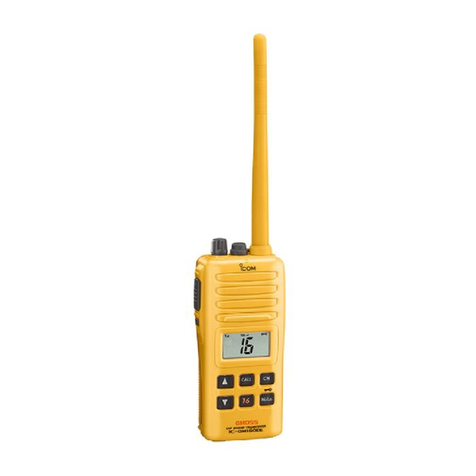
Icom
Icom IC-GM1600E User manual
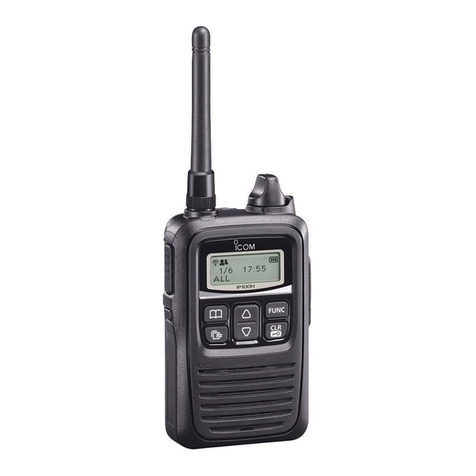
Icom
Icom IP100H User manual
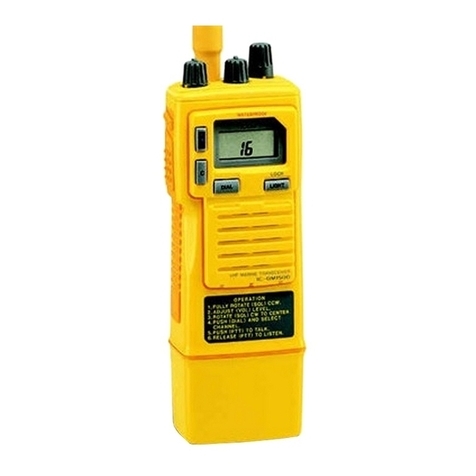
Icom
Icom IC-GM1500 User manual
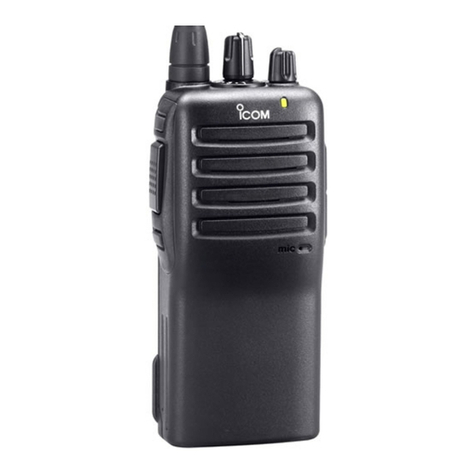
Icom
Icom CS-F14 User manual
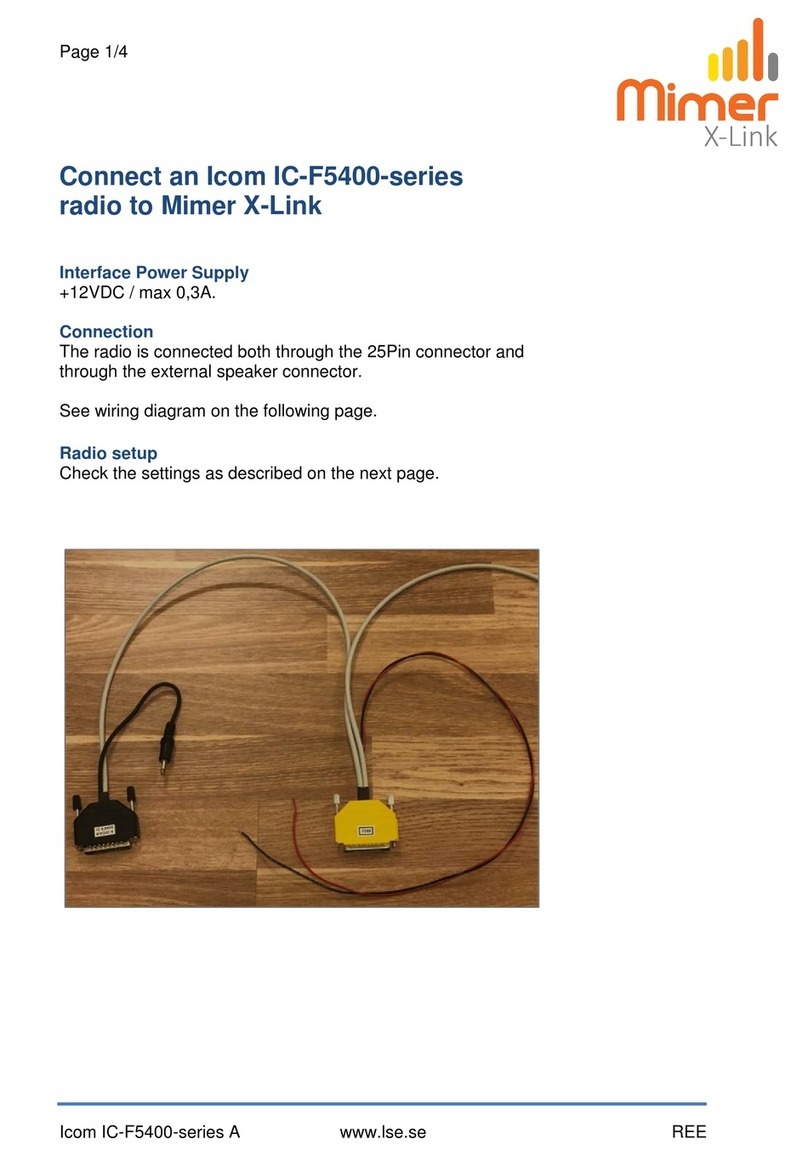
Icom
Icom IC-F5400 Series User manual

Icom
Icom IP100H User manual
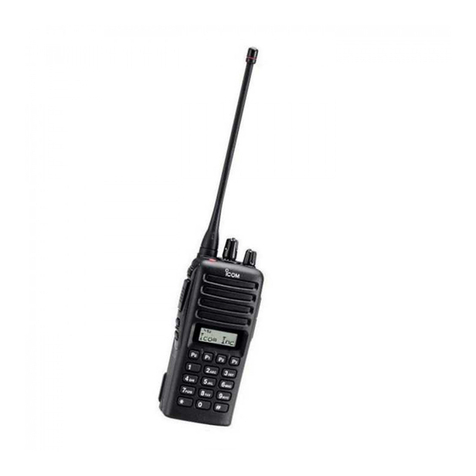
Icom
Icom IC-F43GT Operating instructions
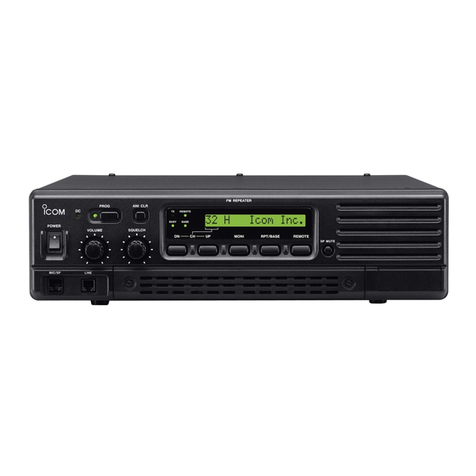
Icom
Icom IC-FR3000 Series User manual
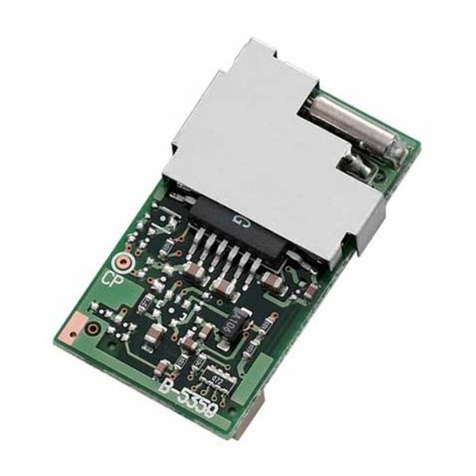
Icom
Icom UT-109 User manual
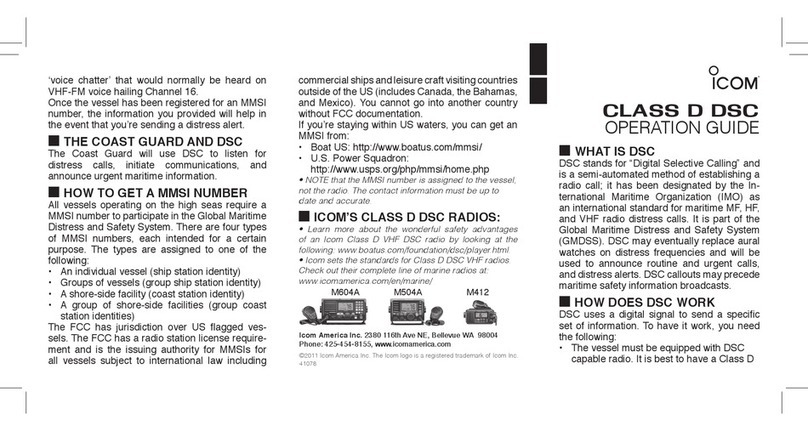
Icom
Icom M604A User manual
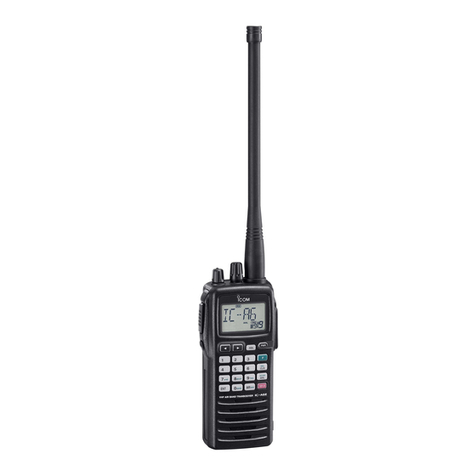
Icom
Icom IC-A24 User manual
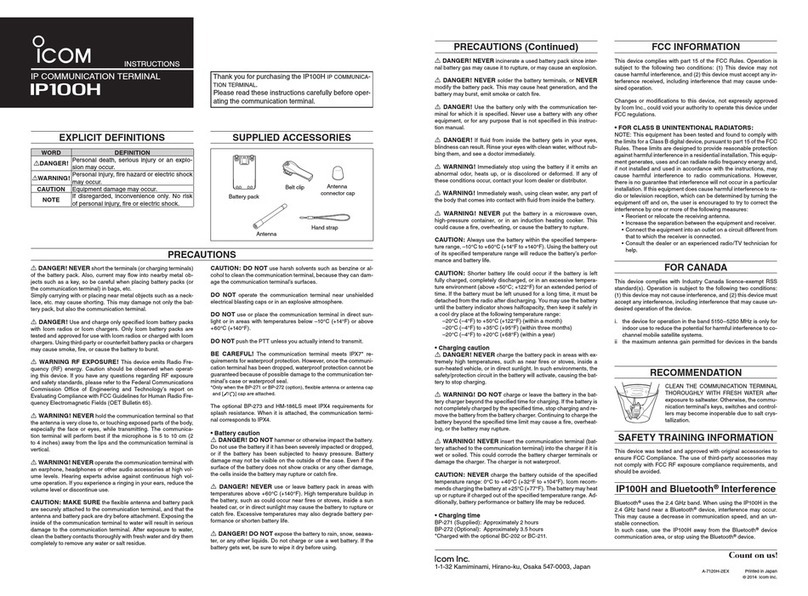
Icom
Icom IP100H User manual

Icom
Icom IC-GM1500 User manual

Icom
Icom IC-F40GT User manual
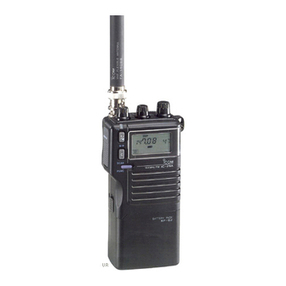
Icom
Icom IC-2SA User manual

Icom
Icom IC-2200H Installation and operating instructions
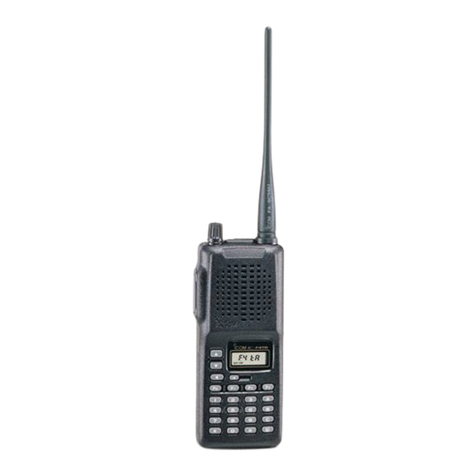
Icom
Icom IC-F4TR User manual
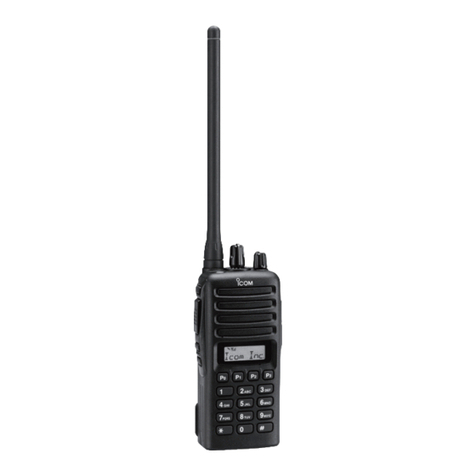
Icom
Icom IC-910H Operating instructions
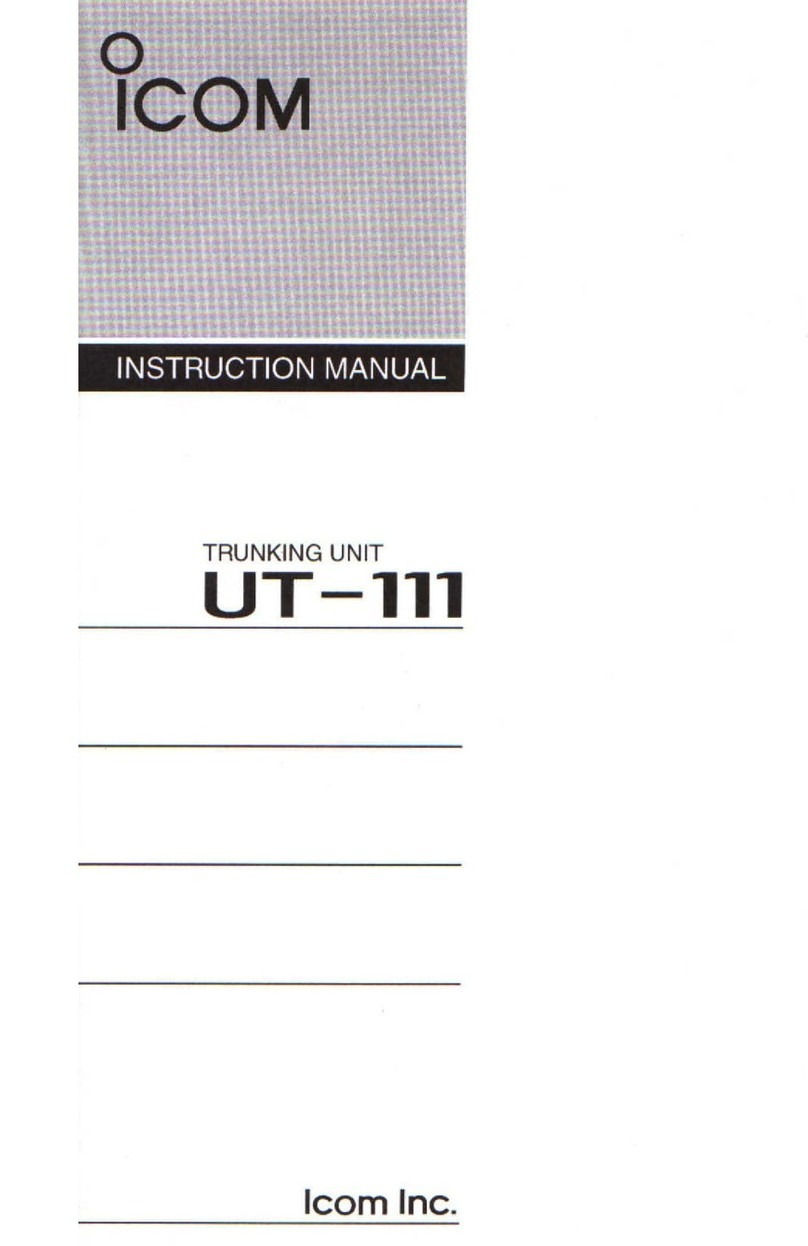
Icom
Icom UT-111 User manual
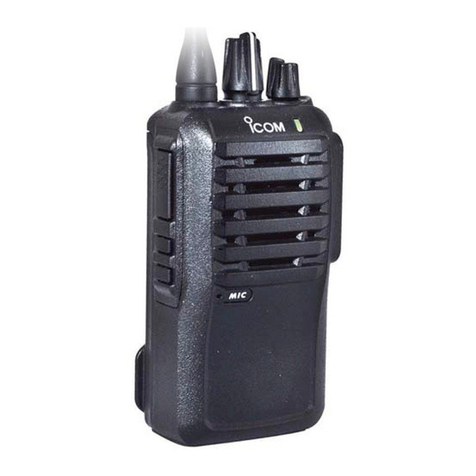
Icom
Icom IC-F3001 User manual

